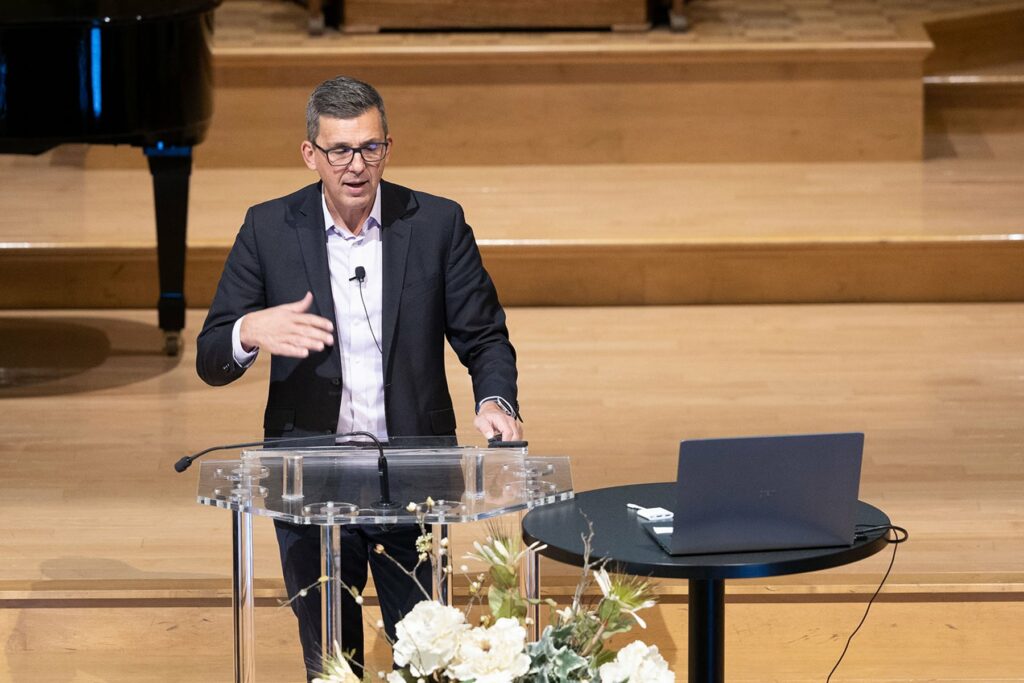Conference at Andrews University Explores Adventist Identity
It is a much-needed discussion in the 21st century, event organizers said.
October 27, 2022 | Berrien Springs, Michigan | Isabella Koh, Andrews University, and Adventist Review
On October 15-19, 2022, Andrews University (AU), a Seventh-day Adventist institution in Berrien Springs, Michigan, United States, hosted a conference titled “Being the Remnant: Adventist Identity in History and Theology.” The event brought together more than 30 scholars for an interdisciplinary conversation about Adventist identity. The conference was sponsored by the Office of Archives, Statistics, and Research (ASTR) in collaboration with the Biblical Research Institute (BRI), the Ellen G. White Estate, and the Department of Church History at the Seventh-day Adventist Theological Seminary at Andrews University.
David Trim, director of the ASTR and a co-planner of the conference, noted, “Conversations about Adventist identity will always be important because there is a trend among Christian churches to gradually suffer ‘mission drift’ and to lose their original focus and passion. Right now is particularly important for a conference on Adventist identity as the church grows rapidly in certain parts of the world. With rapid growth comes the danger of a shift in identity. It’s essential we talk about what it is that makes us distinctly Seventh-day Adventist, and then that we share that with the world church.”
AU associate professor of church history John W. Reeve said that the Adventist identity conference had been in the works for about four years. “As the planning team built the goals and structure and understanding of what we’re trying to do, we focused on understanding our past and our present in order to have a good future,” he said.

Ante Jeroncic, professor of ethics and theology at the Seventh-day Adventist Theological Seminary at Andrews University, presents at the conference on Adventist identity. [Photo: Darren Heslop]
The conference consisted of a total of 10 sessions. In each, scholars were invited to share their research with an in-person and livestreamed audience of over 1,500 people. Two sessions were foundational, covering theories of identity and worldview, one provided historical background, and the final seven each centered on a topic by which Adventists have been defined, including eschatology, healthy living, mission, education, and the Sabbath. A wide range of disciplines were represented throughout the course of the presentations, including history, biblical theology, historical theology, philosophy, and sociology.
Cheryl Doss, retired director of the Institute of World Mission at the General Conference of Seventh-day Adventists and adjunct professor of mission studies and religious education at Andrews University, served as chair for one of the central sessions. “We learned that there is a substantial amount of coherence in Adventists’ commitment to our beliefs and lifestyle, although how that works out may vary around the world,” Doss said. “We are united by our desire to live by biblical principles while grappling with the issues that arise in our various sociocultural contexts.”
Trim, who presented a synopsis of the 30 main papers at the conference, was struck by the integrated nature of Adventist doctrines, including the centrality of Christ, the Great Controversy, the Sanctuary doctrine, and the doctrine of the Remnant. The presentations throughout the conference highlighted a series of shared beliefs, practices, and stories that remain central to Adventism. Trim found particular value in the centrality of storytelling as a way of forming a common identity. “The stories we tell about our Adventist past have a power to bind us together and to inspire,” he said.
Reflecting on the conference, Reeve said he found value in the conversation about the centrality of Christ through all Adventist doctrine. “This is part of our identity as Christians, in the larger church — the church of God universal throughout the world — but also to every single one of our distinctive doctrines,” Reeve said. “Jesus Christ is center.” He also reflected on the role of mission, emphasizing, “The core of our Adventist identity is mission — how we act, what we tell, and who we tell about who our God is and what he has done for us. Really, when it comes down to it, we are depending on Jesus for our salvation and for our future. This is the message of Jesus that we need to get to the world.”
Affirming the importance of Adventist identity, Doss added that the church “must periodically reassess what in our collective identity is changing and what is staying the same. As time passes and society changes, a thoughtful conversation about our collective identity can help shape our self-understanding and guide the church in making wise decisions about our mission. Such an ongoing conversation is needed in the 21st century.”
Recognizing this need, the team has made plans to foster these ongoing conversations worldwide. “We are planning a number of worldwide follow-up Adventist identity conferences, the goal being to have an Adventist identity conference over the next 3-4 years in every division, to include the voices in this conference as well as local voices in every location,” he said.
According to AU president Andrea Luxton, “a clear sense of identity is what gives us focus and enables us to be united.” She added, “It is particularly relevant today as we are in a very divisive time in the world. It is easy for that to impact us in the church. This can result in us expending unnecessary energy in attacking each other and/or defending a position, rather than focusing together on shared mission because of shared identity.” She went on, “I hope that participants and attendees walked away with a strong sense of how a robust understanding of the nuances of Adventist identity deepens unity and results in a strong sense of mission.”
The original version of this story was posted by Andrews University.